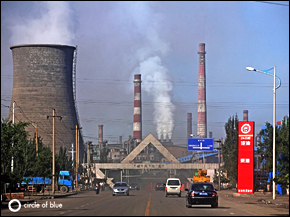Environmental Policy Council Advises Cut in China’s Carbon Intensity

The environmental group will submit a proposal Friday to Premier Wen Jiabao, report says.
China should reduce its carbon intensity by 4 to 5 percent per year to achieve goals of low-carbon development by 2050, according to a proposal from an environmental policy group reported by the China Daily.
The proposal from the China Council of International Cooperation on Environment and Development (CCICED) is the first time such a high-level organization has proposed firm targets for emissions, according to the China Daily. The council comprises world experts in various fields who make policy recommendations to the Chinese government.
The report also recommended China institute a carbon tax by 2020 to encourage low-carbon growth, the China Daily reports.
China’s success at cutting its energy intensity in the last five years could encourage the carbon intensity paradigm, according to Jennifer Turner, director of the China Environment Forum at the Wilson Center.
“This proposal fits onto an existing policy model and would build on a past success in lowering energy intensity. However, the big question is how they would get the data to implement this,” Turner said.
In September at a United Nations summit on climate change President Hu Jintao said China would make a notable reduction in emissions but did not say by what amount.
“We will endeavor to cut carbon dioxide emissions per unit of GDP by a notable margin by 2020 from the 2005 level,” Hu told the delegates.
The extent to which developing countries such as China and India should cut their emissions has been a major sticking point in negotiations leading up to the Copenhagen summit in December. India’s prime minister said his country will not sacrifice its development for climate change.
Carbon intensity measures how much carbon is emitted per unit of output, usually determined by GDP. Even if a country cuts its carbon intensity, total emissions may rise if the economy is growing quickly.
China emitted 2.85 metric tons of carbon dioxide per $1,000 of output in 2006, according to the Energy Information Administration. India emitted 1.8 metric tons/$1,000, and the United States, 0.52/$1,000.
Source: China Daily
China Council for International Cooperation on Environment and Development
Global Carbon Intensity Figures from the Energy Information Administration
Read more about how the people of China view Climate Change and Water.
Brett writes about agriculture, energy, infrastructure, and the politics and economics of water in the United States. He also writes the Federal Water Tap, Circle of Blue’s weekly digest of U.S. government water news. He is the winner of two Society of Environmental Journalists reporting awards, one of the top honors in American environmental journalism: first place for explanatory reporting for a series on septic system pollution in the United States(2016) and third place for beat reporting in a small market (2014). He received the Sierra Club’s Distinguished Service Award in 2018. Brett lives in Seattle, where he hikes the mountains and bakes pies. Contact Brett Walton











Leave a Reply
Want to join the discussion?Feel free to contribute!